Best Sunscreens of 2022
Protect your skin against the sun's damaging UV rays by using CR's ratings of dozens of sun protection products
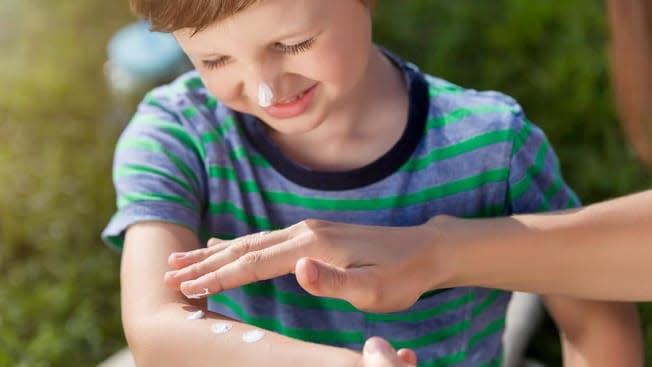
By Trisha Calvo
Sunscreen really is a year-round product, but many people think about stocking up on it only when warm weather arrives and supermarkets and drugstores begin to prominently display dozens and dozens of lotions and sprays. With so many choices, how do you pick?
Dermatologists always say that the best sunscreen is the one you’ll actually use. Consumer Reports’ sunscreen ratings will help you find a lotion or spray that protects your skin and has a scent and feel that’s right for you.
We’ve added several new sprays and lotions to our ratings. Other sunscreens listed, such as La Roche-Posay Anthelios 60 Melt-In Sunscreen Milk lotion and Equate (Walmart) Sport Lotion SPF 50, are reformulations of previously tested products.
CR recommends five products. And among the new crop of products, we found a few that while not at the top of the ratings still provide adequate protection. Keep in mind, though, that using any sunscreen on exposed skin is better than no sunscreen when you’re spending time outdoors. And even the best sunscreen can’t do its full job if you don’t use enough or you don’t reapply every 2 hours you’re in the sun.
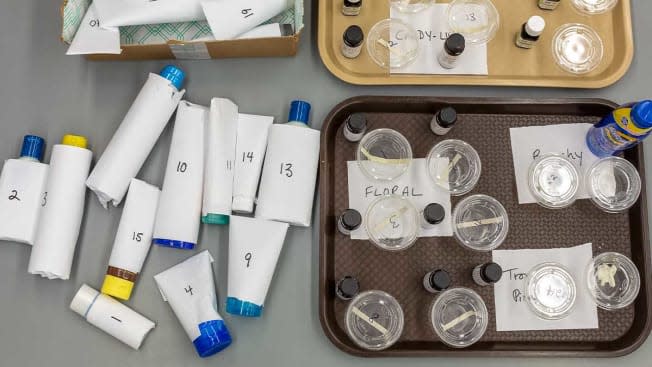
CR's panel of sensory testers evaluate sunscreens for scent and feel.
Photo: John Walsh/Consumer Reports
How We Test Sunscreens
CR uses a testing protocol that’s modeled on the one the Food and Drug Administration requires sunscreen manufacturers to use. But as is the case with other products we test that have government or industry standards, we use those standards as benchmarks and develop our own methodology to identify differences in performance and give consumers a comparative evaluation.
“We buy the sunscreens for our tests off the shelf, the way consumers would,” says Susan Booth, who oversees our sunscreen testing. “We use three samples, preferably with different lot numbers, of each product.” All the products are tested for SPF and ultraviolet A (UVA) protection.
SPF, or sun protection factor, is a measure of how well a sunscreen protects against sunburn, which is mostly the result of exposure to the sun’s UVB rays.
To check SPF, a standard amount of each sunscreen is applied to a 2x3-inch rectangle on panelists’ backs. Then they soak in a tub of water. Afterward, smaller sections of that area are exposed to five to six intensities of UV light from a sun simulator for a set time. About a day later, a trained technician examines the areas for redness. The resulting SPF ratings—Excellent to Poor—reflect each product’s effectiveness after water immersion and are based on an average of our results for each sunscreen. We also calculate a score for variation from SPF. This is a measure of how closely a sunscreen’s tested SPF matched the SPF on the label.
In order to be labeled “broad spectrum,” the FDA requires that a sunscreen protect against UVB and UVA rays. UVA rays penetrate deeply into the skin and cause damage that can lead to skin cancer and skin aging.
To test for UVA protection, we smear sunscreen on plastic plates, pass UV light through, and measure the amount of UVA and UVB rays that are absorbed. That information is used to calculate our UVA score.
This test is similar to the critical wavelength test the FDA requires sunscreen manufacturers to do in order to label their products broad-spectrum. This is a pass/fail test, and just as you can pass a test with either an A or a D grade, some sunscreens do a much better job of defending against UVA than others. That’s why, for our ratings, we also use a test that allows us to measure the degree of UVA protection a sunscreen provides.
Finding a Sunscreen You’ll Want to Use
For many people, the way a sunscreen smells and feels on their skin is as important as the UV protection it provides. So in addition to our performance tests, our trained sensory panelists also evaluate sunscreens for scent and feel. The sensory testing isn’t factored into our Overall Score. What people prefer is subjective, so we can’t say, for instance, whether a sunscreen that has a tropical aroma is better than one with a classic beachy aroma. But our panelists objectively describe the scent and feel of every sunscreen we test so that you can pick the best product for you.
Environmental concerns also drive sunscreen choices. A majority of the sunscreens in our ratings don’t contain oxybenzone or octinoxate. These two chemical active ingredients are highly effective UV filters, but they’re the ones that are most often flagged as being potentially harmful to coral reefs.
All of the sunscreens at the top of CR’s ratings contain chemical active ingredients, such as avobenzone. Some people may prefer to use a mineral, or natural, sunscreen—those with zinc oxide, titanium dioxide, or both. See “Best Mineral Sunscreens of 2022” for CR’s picks.
We also include the price per container and the price per ounce so that you can weigh all the factors when you’re choosing a sunscreen.
Below are some of the top-performing sunscreens in our tests, listed in alphabetical order within their category. CR members have access to our full ratings.
Best Lotion Sunscreens
It’s easier to make sure you’re getting adequate coverage with a lotion than with a spray because you can see how much you’re applying. Use about a teaspoon per body part or area that’s not covered up with clothing: 1 teaspoon for your face, head, and neck; 1 for each arm; 1 for each leg; 1 for your chest and abdomen; and 1 for your back and the back of your neck. If you are in a bathing suit, you’ll need about an ounce of lotion to cover your body. That’s about the amount that fills a shot glass. (Note: The Kiehl’s product below contains oxybenzone.)
Equate (Walmart) Ultra Lotion SPF 50
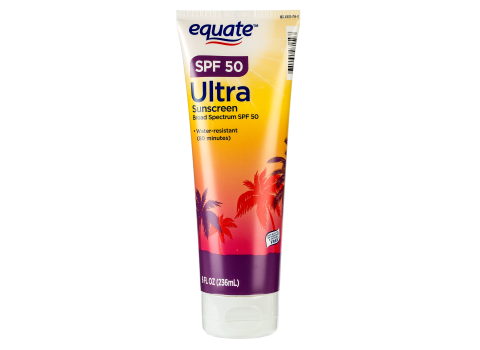
This sunscreen has a tropical coconut scent with notes of baby powder. It leaves a sheen and a slightly greasy film on skin.
Kiehl's Activated Sun Protector Lotion SPF 30
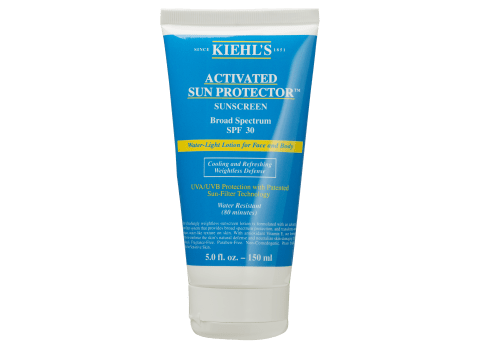
This sunscreen has a slight plastic aroma sometimes associated with fragrance-free products and leaves a light film on skin.
La Roche-Posay Anthelios Melt-In Milk Lotion SPF 60
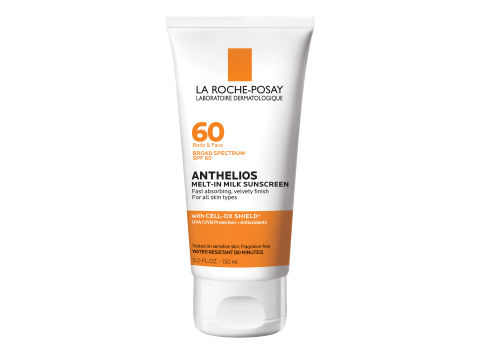
This thin, runny lotion is somewhat greasy and leaves a slight film on skin. Like some fragrance-free products, it has a slight plasticky scent.
Best Spray Sunscreens
Our tests found that if you apply spray properly, you can cover your skin adequately in one pass, but proper application isn’t always easy, especially when it’s windy. Oftentimes you end up protecting the air more than your skin. Spraying the sunscreen into your hand and then applying to your body helps ensure better coverage. But if you don’t do that, hold the nozzle close to your skin and spray until your skin glistens, then rub it in. Do this even if a spray is labeled “no rub”; smoothing it into skin increases its protection. Then repeat, just to be safe. Never spray your face because you could get it in your eyes or inhale it. Instead, spray the sunscreen into your hands and rub it onto your face.
Consumer Reports recommends using a lotion on kids rather than a spray, but if you choose to use a spray, be very careful when applying it. Children are more likely to inhale the mist, which could cause lung irritation. The best thing to do is spray it into your hands and rub it onto your child’s skin. At the very least, have children close their eyes and mouth and turn their head while you spray. And sprays can be flammable when they’re wet, so be sure to keep yourself and kids away from any heat source—such as a grill—until the product is thoroughly dry on the skin.
Alba Botanica Hawaiian Coconut Clear Spray SPF 50
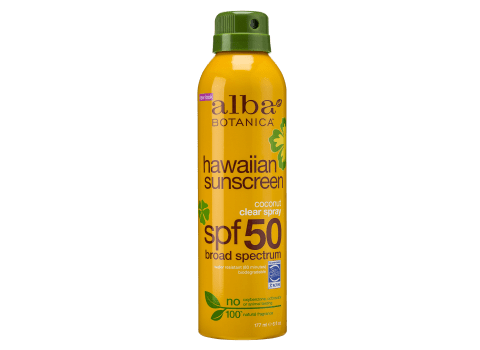
Our testers got a whiff of candylike aroma (but found no hint of the coconut suggested in the product name) from this sunscreen, and found that it leaves a slight film on skin.
Sun Bum Spray SPF 50
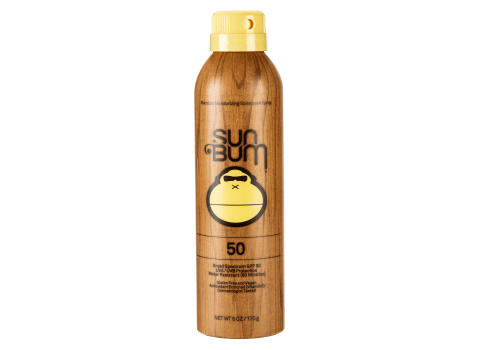
This sunscreen has a slight coconut/tropical aroma and leaves a slightly oily film on skin.
Trader Joe's Spray SPF 50+
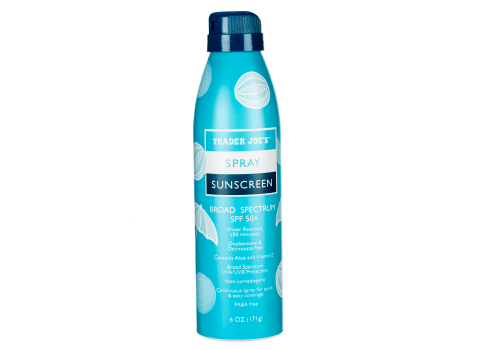
This spray has a slight plastic aroma sometimes associated with fragrance-free products and leaves a very slight film on skin.
More from Consumer Reports:
Top pick tires for 2016
Best used cars for $25,000 and less
7 best mattresses for couples
Consumer Reports is an independent, nonprofit organization that works side by side with consumers to create a fairer, safer, and healthier world. CR does not endorse products or services, and does not accept advertising. Copyright © 2022, Consumer Reports, Inc.

